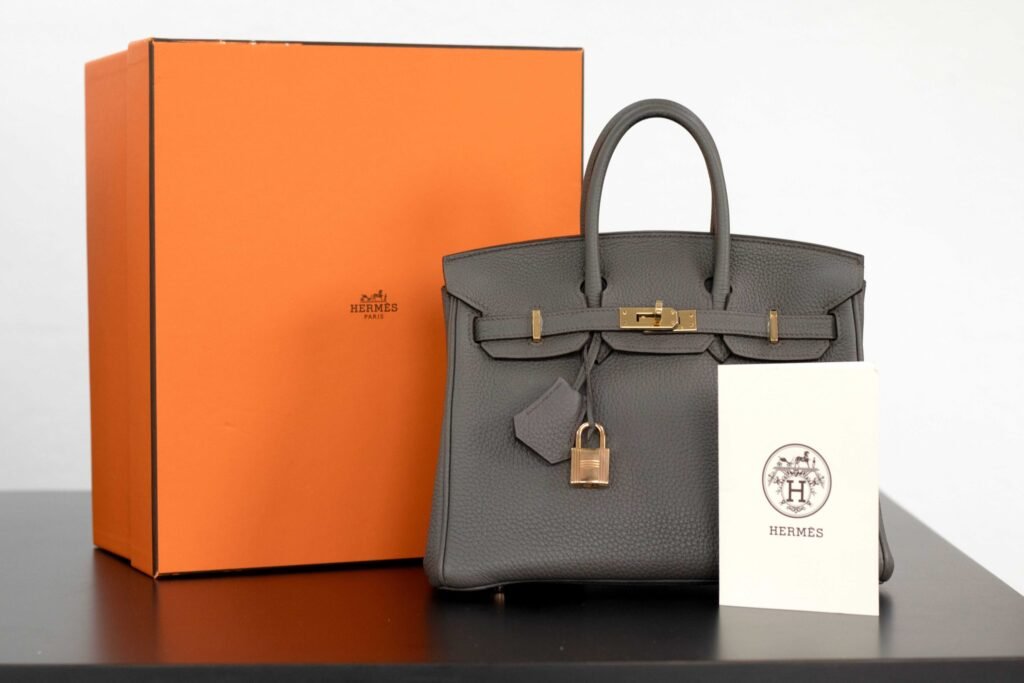Hermès marketing strategy has been one of the main players in the world of luxury for nearly 200 years. Now, they might not be the biggest name you hear tossed around, and they definitely don’t scream for attention like some other brands. But when you start talking about a brand that’s truly desirable, that’s exclusive, that’s expensive — yet known quietly among the elite as the status brand, Hermès kind of stands in a league of its own.
And if you’ve ever wondered how a company manages to stay on top of the luxury game for centuries without falling into trends or overexposing itself, this is exactly the masterclass in marketing you need.
Why Everyone Wants a Birkin
So, Hermès makes a lot of products, but let’s be honest — it’s the handbags that steal the show. The Birkin and Kelly bags are the most coveted pieces in their collection. You’ve got celebrities, world leaders, even royalty, who need to earn the chance to buy one. Analysts say these bags alone make up about a quarter of Hermès’ total revenue. And the crazy part? On the resale market, these things can go for $100,000 or more.

And here’s Hermès marketing strategy trick: desirability is the most important metric to judge a luxury brand. And surprise, surprise — They consistently land at the top of that list.
Even though the world’s going through a bit of a luxury slowdown, Hermès isn’t just holding steady. They’re growing. The secret? A centuries-old strategy built on one word: scarcity. Fewer products, fewer stores, and fewer online sales than what the market could handle. And that’s not by accident. That’s by design.
Hermes Luxury Game
Founded in Paris back in 1837 by Thierry Hermès, the brand started off making high-quality harnesses and saddles for European royalty. Then they moved to the Rue du Faubourg Saint-Honoré in 1880, and they’ve stayed put ever since.
Their products aren’t just pretty things — they’re pieces of history. From the Kelly bag, named after Princess Grace Kelly, to the Birkin, born from a chance encounter with actress Jane Birkin, every product has a story. And storytelling, as any marketer will tell you, is priceless.
Plus, Hermès has always understood its customer — the wealthy customer. They make the highest quality leathers, spend years perfecting stitching techniques, and pay close attention to the lifestyle of their buyers. That combination of craftsmanship, heritage, and understanding what the wealthy truly want? Nobody does it quite like them.
The “You Can’t Sit With Us” Sales Model
Here’s where Hermès marketing strategy turns into pure art. Unlike its competitors, Hermès doesn’t rely on celebrity ambassadors. They barely spend on advertising. You won’t see their name plastered on every magazine cover. And yet, they’re everywhere in conversations about true luxury.
Even the elite need an “in.” You have to build a relationship with a sales associate, make several purchases, and basically prove your worth before you even get a shot at buying a Birkin or a Kelly. There’s a strict quota too—you’re limited to two Birkin or Kelly bags a year.
And what does that do? It makes every bag not just a product but a trophy. When someone’s carrying a Birkin, especially a limited edition, it’s not just about owning the bag. Everyone who knows luxury knows what you went through to get it. You didn’t just spend $12,000. You probably spent five to ten times that on scarves, belts, and other products just to get on the list.
It sounds insane to most people — but it’s Hermès marketing strategy genius.
Hermès Marketing Strategy
Here’s a quick breakdown to make sense of how Hermès plays the luxury marketing game like no other:
- Scarcity over scale: They make less than the market demands. Fewer bags, fewer stores, fewer online sales.
- No celebrity ambassadors: The product speaks for itself.
- Relationship-based selling: Customers must build a buying history to access top products.
- Heritage storytelling: Every product comes with a story linked to icons and history.
- Timeless over trendy: They skip streetwear fads and stick to their DNA.
- Controlled exclusivity: Strict quotas per client maintain elite status.
- Vertical integration: The family still controls the business. No outsiders dictating direction.
- Higher price points, moderate increases: Prices rise slower than competitors, keeping bags both valuable and desirable.
- Minimal innovation in product lines: New materials or editions of classics, but no wild reinventions.
- Reputation-first mindset: Millions spent fighting counterfeits to protect brand integrity.
Riding Market Cycles and Staying True to Their DNA
When you think about the streetwear wave that took over luxury fashion, Hermès didn’t budge. While others chased trends, Hermès stayed true to what made them Hermès. And as those trends faded, it turns out sticking to their DNA was the smarter move.
Even though their store count is much smaller, their revenue per store is dramatically higher than their competitors. That’s why their stock price has soared — hitting over $22,000 a share and lifting their market cap to over $233 billion, even while others saw sharp drops.
Challenges Ahead
Now, Hermès isn’t completely untouchable. There’s a luxury slowdown. Aspirational buyers — people who save up for that one splurge item — are fading away. And while Hermès’ core elite customers are still spending, sales growth in some regions has dipped.
There’s also a class-action lawsuit in California from March 2024. It accuses Hermès of forcing customers to spend thousands just to be eligible to buy a Birkin, saying it violates antitrust law. Imagine any other business where you hand over $12,000 for a bag and get told, “No.” And instead, you have to spend hundreds of thousands on scarves and belts before you can even think about it.
It sounds devious — and it is. But it’s also one of the keys to their success.
The Takeaway
At the end of the day, Hermès isn’t just selling bags or fashion. They’re selling a feeling — of belonging to a world where most people don’t have access. They’ve made exclusivity their entire business model. And for almost two centuries, it’s worked.
They fight above their weight in profits, in status, and in influence. And for any marketer out there, whether you’re working in luxury, tech, or even food, there’s a ton to learn from how Hermès keeps demand sky-high by intentionally keeping supply — and access — painfully low.
Limited production, rare materials, hand-stitching, zero mass marketing, and making people wait years. Hermès controls demand by making you beg to buy it. That’s what spikes the price.
Scarcity, storytelling, status control. They make people feel lucky just to get on a waitlist. No flashy ads. Desire builds when you can’t easily have something.
Almost never. They believe mass marketing kills exclusivity. When they do, it’s low-key in elite places nobody broke reads. Their real ad is FOMO among the rich.



